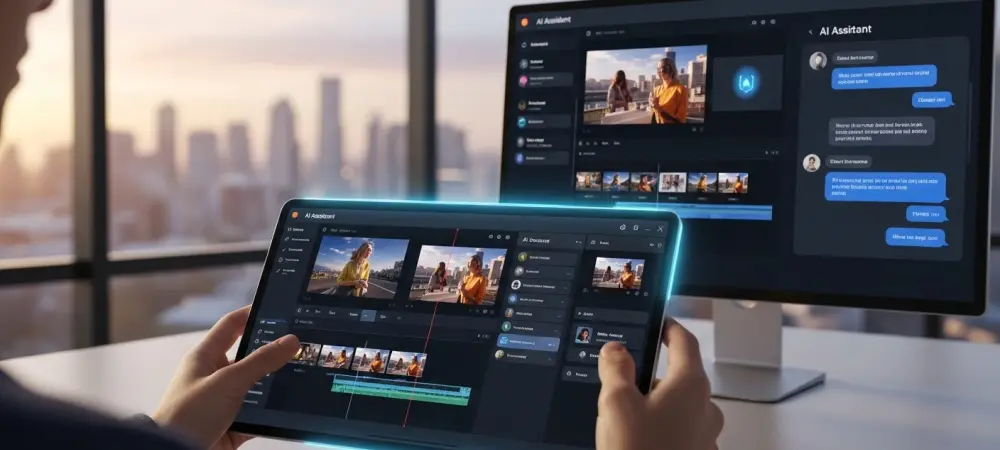Video content reigns supreme in social media engagement, with studies showing that it accounts for over 80% of all online traffic in 2025, underscoring a critical reality for marketers. Video is no longer optional but essential for capturing audience attention. However, growing brands often grapple with the daunting challenge of producing high-performing video content at scale, constrained by limited time and tight budgets. Enter artificial intelligence—a transformative force that automates and accelerates video ad creation. This analysis delves into how AI is revolutionizing video ad scaling, its tangible benefits for brands, and the potential it holds for reshaping digital marketing landscapes.
The Rise of AI in Video Advertising
Explosive Growth and Adoption Trends
The ubiquity of video as a marketing tool is evident, with nearly 90% of businesses incorporating it into their strategies in 2025. This widespread adoption reflects video’s unmatched ability to drive engagement across platforms. Yet, the sheer volume of content required has pushed marketers toward innovative solutions, with AI emerging as a cornerstone of modern advertising efforts.
Industry reports highlight a surge in the use of AI tools for video ad creation, with adoption rates climbing steadily from 2025 onward. Surveys indicate that a significant portion of marketing teams now rely on AI to streamline workflows, cut production times, and manage budgets more effectively. This trend points to a broader shift, where technology is not just a luxury but a necessity for staying competitive.
The momentum behind AI adoption shows no signs of slowing, as more companies recognize its capacity to handle repetitive tasks and deliver data-driven insights. This growing reliance signals a fundamental change in how video campaigns are conceptualized and executed, paving the way for smarter, more efficient marketing strategies.
Real-World Applications and Success Stories
AI’s impact on video advertising is most apparent in its ability to automate complex production tasks. From formatting content for different platforms to generating multiple creative variants, AI slashes costs and enables rapid experimentation. Brands can now produce diverse ad versions without the need for extensive manual input, saving both time and resources.
A compelling example lies in tools like Lucas AI video ads, which empower marketers to create hundreds of on-brand variations tailored to specific audience segments. This technology ensures consistency with brand guidelines while adapting content for varied demographics, allowing for precise targeting. Such capabilities were once the domain of large creative teams, but AI has made them accessible to businesses of all sizes.
Beyond creation, AI facilitates real-time optimization by analyzing performance data to refine future iterations. This iterative process means that each new video batch becomes more effective, as the system learns which elements resonate most with viewers. The result is a scalable, cost-efficient approach that maximizes return on investment.
Expert Insights on AI-Driven Ad Scaling
Industry leaders consistently point to AI as a game-changer in video ad strategies, emphasizing its role in replacing subjective guesswork with concrete, data-driven decisions. Marketing professionals note that AI tools provide actionable insights into what drives engagement, enabling brands to allocate resources more effectively. This shift marks a departure from traditional methods reliant on intuition or trial and error.
Efficiency gains stand out as a key benefit, with experts highlighting how AI reduces dependence on large creative teams or external agencies. Smaller brands, in particular, find this democratization of high-quality video content transformative, as it levels the playing field against larger competitors. The ability to produce professional-grade ads in-house empowers emerging businesses to build a stronger market presence.
Moreover, specialists underscore AI’s potential to foster creativity rather than stifle it, by handling mundane tasks and freeing up human talent for strategic thinking. This balance between automation and innovation is seen as crucial for sustaining brand authenticity while scaling output. Such insights affirm AI’s growing influence as an indispensable ally in modern advertising.
The Future of AI in Video Ad Scaling
Looking ahead, AI is poised to deepen its impact on video ad scaling through advanced personalization and predictive analytics. Future developments could enable tools to anticipate audience behavior with greater accuracy, tailoring content in real-time across diverse platforms. This level of customization promises to enhance viewer relevance and boost campaign effectiveness.
Potential benefits include further cost reductions and sharper creative precision, as AI refines its ability to optimize every element of a video ad. However, challenges loom, such as ensuring content retains an authentic human touch amid automation. Additionally, data privacy concerns must be addressed to maintain consumer trust as AI systems handle increasingly sensitive information.
The broader implications of AI-driven scaling are profound, potentially reshaping competition in digital marketing. As growing brands leverage these tools to rival established players, the industry could see a surge in innovation and diversity. This evolution suggests a future where access to cutting-edge technology becomes a defining factor in marketing success.
Key Takeaways and Next Steps
AI stands as a pivotal force in video ad scaling, offering automation across platforms, data-driven testing, and structured creative workflows. These advantages streamline production and enhance campaign outcomes, making AI an essential component for brands aiming to thrive in a video-dominated landscape. Its ability to adapt content dynamically ensures relevance in an ever-changing digital environment.
Reflecting on the journey, the integration of AI into video advertising has proven to be a turning point, empowering brands to overcome traditional barriers of cost and scale. The strides made in efficiency and precision have set a new standard for what is achievable, even for smaller players in the market.
Moving forward, brands are encouraged to embrace AI tools as a means to experiment with scalable video strategies. Exploring these technologies offers a pathway to uncover what resonates with audiences, driving growth in a competitive arena. The focus has shifted to continuous learning and adaptation, ensuring that marketing efforts remain agile and impactful.

